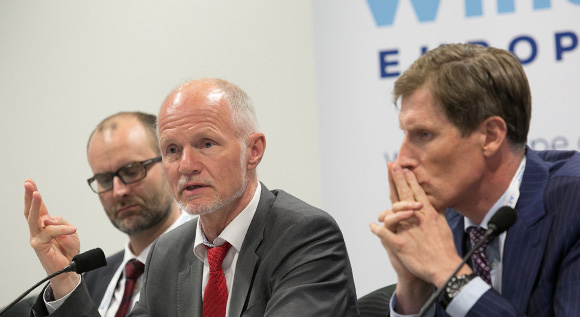Powering ahead with offshore wind energy
Offshore wind energy is to be significantly expanded in Europe up to 2030. At the start of June, Germany, Belgium and Denmark affirmed their intention to continue their close cooperation on this.
 © WindEurope
© WindEurope
Germany, Belgium and Denmark have affirmed their intention to expand offshore wind energy up to 2030 and to work closely with one another in the North Sea. It is currently being examined whether targeted EU funding can be provided to be used as grants for strategic joint projects in addition to national measures. Policymakers for energy from each of the three countries joined together with representatives from the wind industry at the Offshore Wind Energy 2017 conference in London in early June, where they signed a statement on this cooperation. Germany was represented at the event by State Secretary Rainer Baake from the Federal Ministry for Economic Affairs and Energy. Ten North Sea countries already signed a joint declaration with the EU Commission a year ago, in which they have agreed to cooperate more closely in the energy sector.
The race for technological advancement
At the end of 2016, wind farms in Europe had a combined installed capacity of 12.63 gigawatts (GW) that was connected to the European power grid, mainly in the North Sea (to see how this was distributed across the continent, click on our Infographic). The offshore industry is pursuing ambitious goals. As set out in the declaration, it plans to install 60 GW of new capacity by 2030. In the run-up to the offshore conference, State Secretary Baake held a speech in which he said Germany would contribute a significant share of this figure, with the country’s expansion target set at 15 GW. He also said that it was very clear that Europe has reached the critical market volume needed for scaling up manufacturing processes to an industrial level and for optimising the logistics chain. According to the State Secretary, manufacturers of plant and equipment are locked in a tough race to be quickest to make the greatest technological advancements. He also highlighted that Germany was the only country in Europe which has already set down an expansion target for 2030 in law.
State Secretary Baake: driving grid expansion forward
State Secretary Baake went on to note the great success of the first round of auctions for offshore wind installations in Germany, the result of which is that three of the wind parks selected will be built without receiving any funding whatsoever. He did, however, emphasize that the expansion of offshore wind energy in Germany would be guided by auctions, as it was imperative for electricity to reach the consumer. Only once this really works, he said, will the bids for zero funding have a real impact. And this is why all players in Europe have to drive forward with grid expansion, he argued. According to the State Secretary, defining a reliable expansion corridor for offshore wind energy is vital in order to further optimise costs in the industry.
Revision of the Cross-Border Renewable Energy Ordinance (GEEV): cross-border auctions for onshore wind
There are also plans to increasingly expand onshore wind energy by making use of capacity cross-border, with the aim to deepen integration in the European energy sector. This has led Germany to undertake a revision of its Cross-Border Renewable Energy Ordinance (GEEV). The Ordinance has so far only covered solar installations, for which initial pilot auctions with Denmark (German only) have been tested. In the future, however, this legislation is also to apply to auctions for onshore wind installations.

